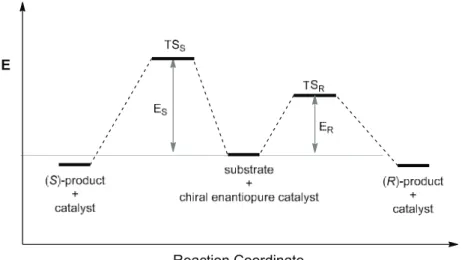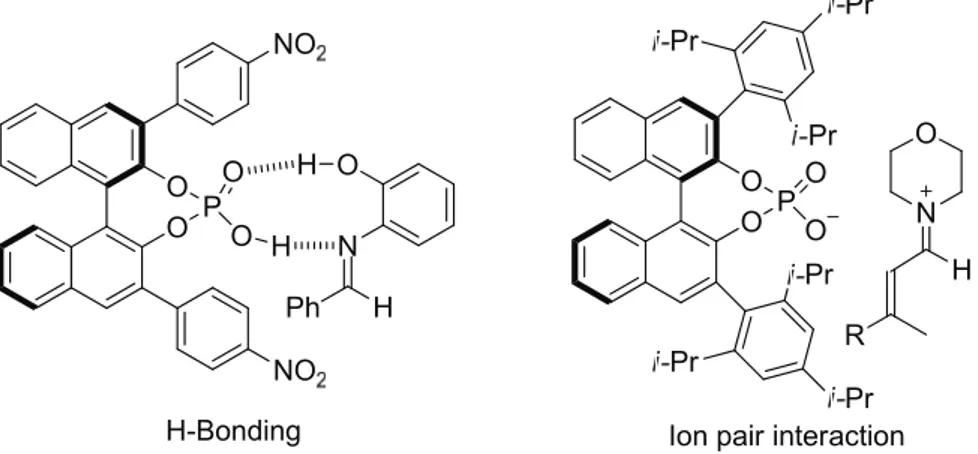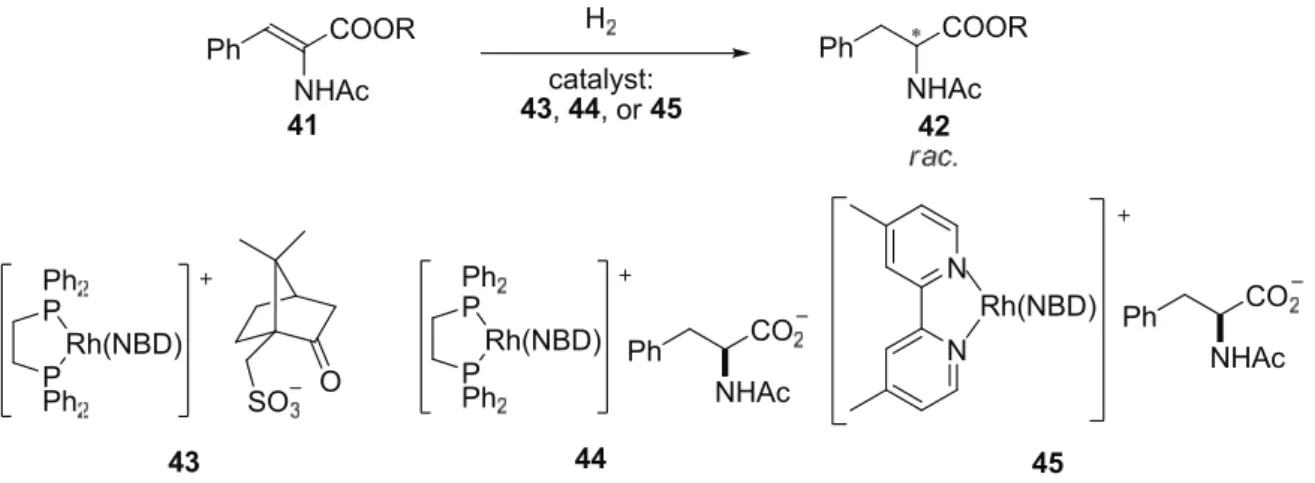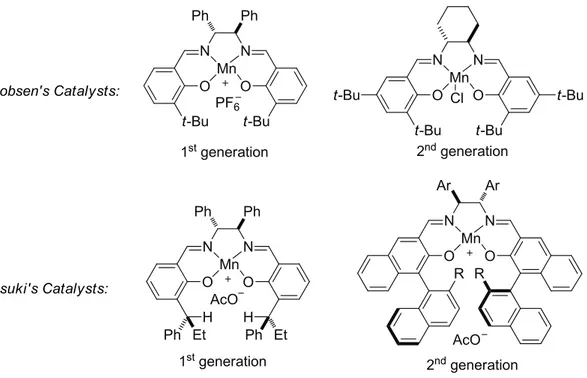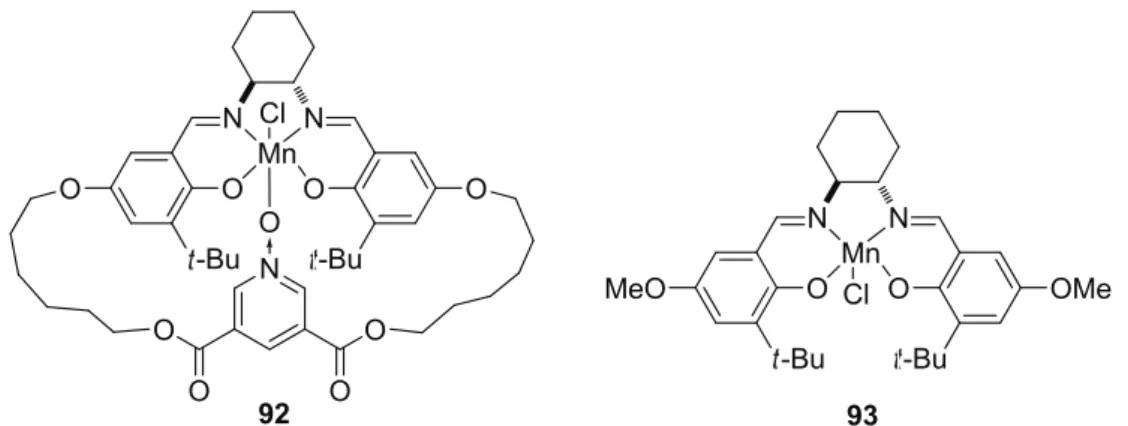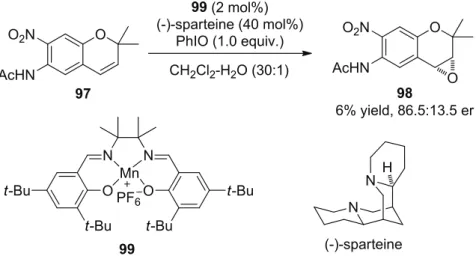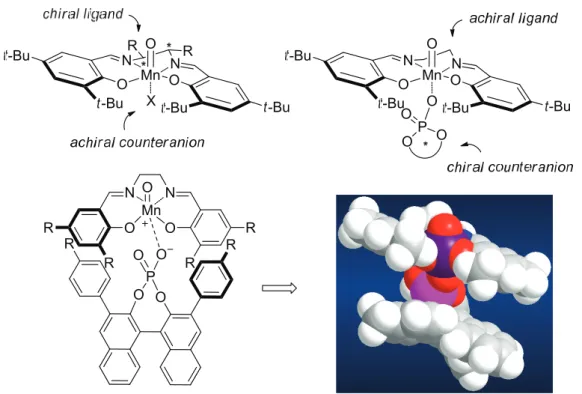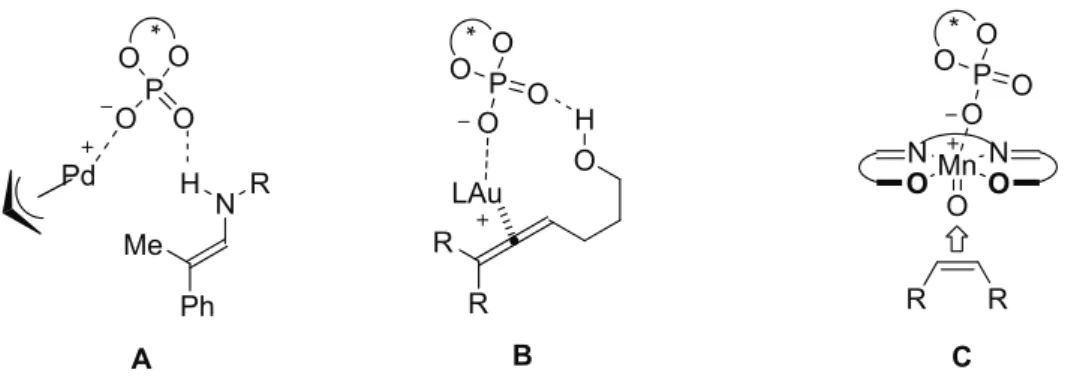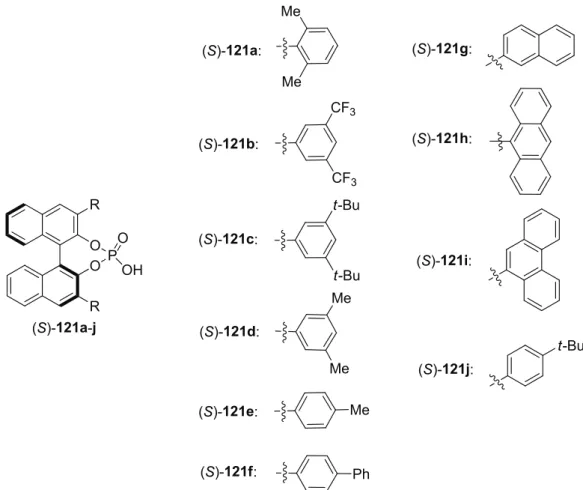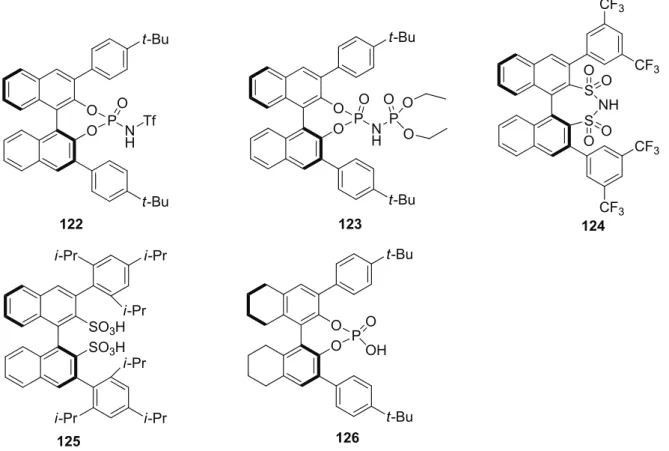Asymmetric Counteranion-Directed Transition Metal Catalysis: Enantioselective Epoxidation and
Sulfoxidation with Ion-Pair Catalysts
Inaugural-Dissertation Zur
Erlangung des Doktorgrades
der Mathematisch-Naturwissenschaftlichen Fakultät der Universität zu Köln
vorgelegt von
Saihu Liao aus Hunan (VR China)
Mülheim an der Ruhr 2011
Berichterstatter: Prof. Dr. B. List Prof. Dr. A. Berkessel
Tag der mündlichen Prüfung: 28. März 2011
Abstract
Based on the concept of “asymmetric counteraion-directed catalysts (ACDC)”, a series of ion- pair catalysts containing an achiral metallosalen cation and a chiral anion was designed and prepared for the asymmetric epoxidation of unfunctional alkenes and the oxidation of sulfides.
With the optimal ion-pair catalyst that consits of an achiral Mn-salen cation and a chiral BINOL-derived phosphate anion, high yields and enantioselectivities were obtained in the epoxidation of various alkenes like chromenes and cinnamates. With this type of ion-pair catalysts, a level of enantioselectivity similar to Jacobsen’s Mn-salen catalyst was observed in the asymmetric oxidation of sulfides. The corresponding iron complex was found much more efficient for sulfoxidation, and the high enantioselectivities observed in the cases of electron- poor sulfides are unprecedented in Mn- or Fe-based metallosalen systems.
The combination of chiral salen ligands and chiral counteranions has also been investigated.
In the epoxidation of alkenes with the configuration-matched ion pairs the enantioselectivity of the Mn-salen complexes consisting of only chiral salen ligands can be further improved.
The application of the ACDC concept to porphyrin chemistry was also attempted. Substantial
albeit low enantioselectivity was observed in epoxidation reactions. These results further
demonstrate that ACDC can be employed as a general strategy in the arena of asymmetric
transition metal catalysis.
Kurzzusammenfassung
Basierend auf dem Konzept der “asymmetrischen Gegenion-vermittelten Katalyse” (engl.
asymmetric counteranion-directed catalysis - ACDC), wurden eine Reihe von Ionenpaaren als Katalysatoren, bestehend aus achiralen Metallosalen-Kationen und chiralen Gegenionen, modelliert und synthetisiert. Diese konnten für die asymmetrische Epoxidierung von unfunktionalisierten Alkenen sowie die Oxidation von Sulfiden eingesetzt werden. Mit dem optimalen Katalysator, der Kombination eines achiralen Mn-Salen Kations und einem chiralen BINOL-abgeleiteten Phosphat-Anion, konnten hohe Ausbeuten und Enantioselektivitäten in der Epoxidierung von Alkenen, wie zum Beispiel Chromenen und Cinnamaten, erzielt werden. Ebenso konnten mit diesem Ionenpaar Sulfide asymmetrisch oxidiert werden, die Enantioselektivitäten waren ebenbürtig zu den Ergebnissen, welche mit Jacobsen`s Mn-Salen Katalysatoren erzielt wurden. Der entsprechende Eisenkomplex zeigte sich effizienter bezüglich der Sulfoxidierung elektronenarmer Sulfide, und konnte verglichen mit bisherigen Mn- oder Fe-basierten Metallosalen-Systemen überlegene Ergebnisse liefern.
Die Kombinationen aus chiralen Salen-Liganden und chiralen Gegenionen wurden ebenfalls untersucht. Hierbei stellte sich heraus, dass die Enantioinduktion in der Epoxidierung von Alkenen mit den konfigurativ passenden Ionenpaaren (engl. matched pair) weiter verbessert werden konnte.
Die Anwendung des ACDC-Konzeptes in der Porphyrin-Chemie wurde ebenfalls untersucht.
Vielversprechende Enantioselektivitäten konnten auch hier für verschiedene
Epoxidierungsreaktionen erzielt werden. Diese Tatsache unterstreicht das große Potential von
ACDC als genereller Strategie in der asymmetrischen Übergangsmetallkatalyse.
Table of Contents
1 Introduction ... 1
2 Background... 4
2.1 Asymmetric Conteranion-Directed Catalysis (ACDC)... 7
2.1.1 Asymmetric Counteranion-Directed Organocatalysis ... 7
2.1.2 Asymmetric Counteranion-Directed Transition Metal Catalysis... 15
2.2 Jacobsen-Katsuki Epoxidation ... 28
2.2.1 Effects of Added Donor Ligands ... 29
2.2.2 Effects of Anions and Counteranions... 33
3 Concept... 36
4 Results and Discussion ... 39
4.1 Enantioselective Epoxidation of Alkenes with Mn
III-Salen Phosphate Ion-Pair Catalysts ... 39
4.1.1 The Initial Studies ... 39
4.1.2 Structural Optimization of the Ion-pair Catalysts ... 46
4.1.3 Further Optimization of Reaction Conditions... 65
4.1.4 Substrate Scope and Limitation... 72
4.1.5 Other Aspects Considering the Ion-Pair Catalysts... 78
4.1.6 Conclusion... 84
4.2 Enantioselective Oxidation of Sulfides with Mn- and Fe-Salen Phosphate Ion-Pair Catalysts ... 86
4.2.1 Introduction ... 86
4.2.2 Investigation of the Reaction Scope... 88
4.2.3 Conclusion... 94
4.3 Enantioselective Epoxidation of Alkenes with Ferric Porphyrin Phosphate Ion-Pair Catalysts ... 95
4.3.1 Introduction ... 95
4.3.2 Preparation of Ferric Porphyrin Phosphate Ion Pairs... 99
4.3.3 Preliminary Results and Limitation... 101
4.3.4 Conclusion... 105
5 Summary and Outlook... 106
6 Experimental Part ... 108
6.1 General Experimental Conditions ... 108
6.2 Preparation of Mn-Salen Phosphate Complexes... 111
6.2.1 Preparation of BINOL-Derived Phosphoric Acids ... 111
6.2.2 Synthesis of Silver Phosphates... 153
6.2.3 Preparation of Achiral Mn-Salen Complexes ... 154
6.2.4 Preparation of Achiral Cr, Fe, and Co-Salen Complexes ... 171
6.2.5 Preparation of Ion-Pair Catalysts ... 173
6.3 Preparation of Oxidants... 175
6.4 Synthesis of Alkene Substrates ... 176
6.4.1 Synthesis of Chromene Substrates ... 176
6.4.2 Synthesis of Other Alkene Substrates ... 191
6.5 Synthesis of Racemic Epoxidation Products... 195
6.6 Asymmetric Epoxidation of Alkenes with Ion-Pair Catalysts ... 196
6.7 Asymmetric Oxidation of Sulfides with Mn
IIIand Fe
IIIIon-Pair Catalysts ... 208
6.7.1 Synthesis of Sulfide Substrates and Racemic Sulfoxides ... 208
6.7.2 Enanstioselective Oxidation of Sulfides with Ion-Pair Catalysts... 209
6.8 Epoxidation with Fe
III-Porphyrin Phosphate Ion-Pair Catalysts ... 214
6.8.1 Synthesis of Porphyrin Ligands ... 214
6.8.2 Synthesis of Achiral Fe
III-Porphyrin Complexes ... 222
6.8.3 Synthesis of Fe
III-Porphyrin Phosphate Ion-Pair Catalysts ... 224
6.8.4 Asymmetric Epoxidation with Fe
III-Porphyrin Phosphate Ion-Pair Catalysts224 7 References ... 225
8 Acknowledgements... 231
9 Appendix ... 233
9.1 List of Abbreviations... 233
9.2 Erklärung... 236
9.3 Curriculum Vitae... 237
1 Introduction
The biological activity of many pharmaceuticals, agrochemicals, flavors and fragrances is associated with their absolute molecular configuration, because in biological systems, most of naturally occurring compounds like amino acids and sugars are of the same chirality: amino acids are L and sugars are D, and under this macro-chiral environment in biology, the two enantiomers of a molecule may interact in a different way, even though two enantiomers normally behave identically to each other when in an achiral environment. An example is the different odor of the two enantiomers of celery ketone (Figure 1.1), which have been made recently in our laboratory via enantioselective intramolecular aldolization.
[1]The two enantiomers differ as strikingly in their olfactory properties as in the rare case of carvone.
[2]Only the stronger R enantiomer is responsible for the characteristic celery note of the racemate, whereas the S enantiomer has an aniseed-like liquorice smell with minty facets.
These smell different to most people because our olfactory receptors are chiral molecules (like enzymes) which can discriminate the two enantiomers, leading to different biological responses.
S R
Figure 1.1: The two enantiomeric forms of the natural compound celery ketone.
These differences become especially important, when considering the biological activity of chiral potential pharmaceutical compounds. Usually, only one enantiomer of a chiral drug is active, the other enantiomer is less active or without activity, and can even be detrimental to our body. It is thus highly important and desirable to prepare molecules in an enantiomerically pure form for meaningful investigation of their biological effects and other properties, and the demand is growing.
Enantiomerically pure molecules can be prepared by resolution of racemic compounds or by
asymmetric synthesis from chiral or achiral starting materials. Chiral resolution is a classic
way to obtain optically pure compounds and well established in industry, while this approach
is not atom economic, because the highest yield of the desired enantiomers is only 50%. For
asymmetric synthesis, there are four major types of approaches: substrate-, auxiliary-, reagent- and catalyst-controlled asymmetric synthesis. In the former three asymmetric synthetic methods, stoichiometric amounts of chiral compounds are required and consumed to obtain the desired chiral products, while in the catalyst-controlled asymmetric synthesis chiral catalysts are used as the source of chirality. Thus, the asymmetric catalytic approach stands as the most economic way to produce chiral compounds, because the chiral catalysts are kept intact after the transformation and the multiplicity of chirality can be infinite.
Asymmetric biocatalysis, metal catalysis, and organocatalysis are the three principal areas in the field of asymmetric catalysis. Over the last forty years, asymmetric catalysis has been the focus of intensive studies in the chemical community, and significant progress have been achieved in this area, like the 2001 Nobel Prize in Chemistry awarded to K. Barry Sharpless, William S. Knowles and Ryoji Noyori for their contribution to the asymmetric transition- metal catalysis
[3]and the renaissance of organocatalysis in the last decades.
[4]Similar to the classification of chemical bonds, based on the association and interaction between chiral sources and substrates, the modes of asymmetric induction in catalysis can be mainly divided into three classes: covalent, ionic, and weak interaction (Figure 1.2). The covalent induction is most common in asymmetric catalysis like the activation of double or triple bonds by noble metals and the enamine formation in aminocatalysis (A, Figure 1.2).
Weak interacions (π-π, H-bonding etc.) in catalysis are also widely employed, especially in organocatalysis, like thiourea- and Brønsted acid-mediated reactions (B, Figure 1.2).
Comparing with the covalent activation and weak interaction in asymmetric catalysis, the type of ionic interaction, where the chirality is delivered to the substrate via contact cation/anion ion-pair communication from the chiral counterions, is far less studied and employed. The most known examples meight be the chiral ammonium-medated phase-transfer catalysis (C, Figure 1.2).
Figure 1.2: The modes of chiral induction in asymmetric catalysis.
Interestingly, if we define the type C catalysis in Figure 1.2 as “asymmetric counteraction- directed catalysis”, its counterpart, namely, “asymmetric counteranion-directed catalysis”
(Figure 1.3) only sporadically appeared in the literature before 2006, and in those earlier attempts none of them provided practical enantioselectivity.
[5]Breakthroughs have been made in 2006-2007 in this special area, and unprecedented high levels of enantioselectivity have been achieved in both organocatalysis and transition-metal catalysis: chiral salt-mediated transfer hydrogenation (A, Figure 1.3),
[6]Au-catalyzed alloxylation of allenes,
[7]and Pd- catalyzed Tsuji-Trost-type allylation of aldehydes
[8](B, Figure 1.3).
Figure 1.3: Asmmetric counteranion directed catalysis (ACDC).
In the field of asymmetric catalysis the major tasks, also the challenges, lie in the design of a
novel and effective chiral catalyst for a given reaction.
[9]The concept of “Asymmetric
Counteranion-Directed Catalysis (ACDC)”, which has been neglected for a long time, will
undoubtedly attract more and more research interest, and the potential of this novel concept as
a general strategy in the design of catalysts and asymmetric reactions will be well
demonstrated under the pursuits of our chemists in the future.
2 Background
In an enantioselective catalytic reaction, the transfer of chirality from the catalyst to the product normally occurs in the transition state (TS) of the enantio-determining step (Figure 2.1). Because the catalyst is chiral, when the prochiral substrate interacts with the catalyst, two diastereotopic transition state namely TS
Rand TS
Sare generated, leading to the (R)- configured and (S)-configured product, respectively. The activation energy difference (E
Rvs.
E
S) between the two diastereotopic TS determines the enantioselectivity of the reaction, and the pathway with the lower activation energy TS (like E
Rin Figure 2.1) will result in the major enantiomer of the product.
Figure 2.1: The reaction coordinate of an enantioselective catalytic reaction.
The rate constant for the formation of each enantiomer in Figure 2.1 can be given by the Arrhenius equation:
k
R= Ae
−ER/RTand k
S= Ae
−ES/RTwhere E
Rand E
Sare the activation energy for the corresponding enantiomers. Since the ratio of the enantiomers (e.r.) formed is equal to the ratio of their rate constants, the selectivity of an enantioselective catalytic reaction can be expressed as:
e.r. (R/S) = k
R/k
S= e
–(ER-ES)/RTIf the energy difference between two diastereotopic TS is 3.0 kcal/mol at 25 °C, the two enantiomers would be formed in a ratio of 99.4:0.6 equal to 98.8% ee. Accordingly, improving the enantioselectivity from 40% ee to 95% ee, only an energy barrier of 1.7 kcal/mol has to be created.
[10]As a result, asymmetric catalytic reactions are sensitive to a variety of factors. To optimize a given asymmetric reaction, apart from the catalysts and substrates, reaction conditions like temperature, solvent, additive also have to be taken into consideration. While most chemical reactions proceed via charged intermediates or transition states, another special factor, the cationic or anionic counterions, may also play an important role in the control of stereoselectivity.
As aforementioned, asymmetric induction is an extremely sensitive phenomenon, a small difference in transition state energies can enable a significant change in enantioselectivity.
This implies that it may be possible to use some subtle features like the counterion effect to conduct a highly selective asymmetric transformation in those reactions proceeding via charged intermediates or transition states. These counterion-directed asymmetric reactions can be divided into two classes according to the charge of the chiral counterion source:
countercation-directed asymmetric reactions and counteranion-directed asymmetric reactions (Figure 2.2).
chiral countercation
anion
cation
chiral counteranion S' is the activated substrate in TS
Figure 2.2: Two classes of counterion-directed asymmetric transformation.
For the countercation-directed asymmetric reactions, phase transfer catalysis using chiral
ammonium salts represents a typical example.
[11]The high level of enantioselectiviy results
from the high degree of organization between the anionic enolate and cationic ammonium. As
shown in Scheme 2.1, one face of the enolate can be efficiently shielded by the chiral
ammonium cation, exposing the other face of the enolate to MeI attack (Scheme 2.1).
[12]t
+ -
t
+ -
2 2 2,
t
Scheme 2.1: The enantioselective alkylation via phase transfer catalysis.
In comparison, the counteranion-directed asymmetric reactions are far less explored. The
chiral counteranion strategy was first employed by Arndtsen and co-workers in the Cu-
catalyzed aziridination and cyclopropanation of olefins using chiral borate anions, however,
only up to 10% ee was observed.
[13]Later on, there were some trials using this principle, but
none of them provided practical enantioselectivity.
[5]Interestingly, highly enantioselective
counteranion-directed reactions were first achieved in organocatalysis,
[6]a novel and rapidly
developing area,
[14]six years after the first attempts of the principle in transition metal
catalysis. The enantioselectivity observed was excellent and unprecedented in counteranion-
directed transformations, and it was also the time when the term of ACDC (asymmetric
conteranion-directed catalysis) was coined. The next section will give a review over the
development of asymmetric counteranion-directed catalysis.
2.1 Asymmetric Conteranion-Directed Catalysis (ACDC)
2.1.1 Asymmetric Counteranion-Directed Organocatalysis
Organic salts that contain a chiral anion as the sole chiral source have rarely been employed as organocatalysts. Only two reports appeared in the literature before 2006: one was from the Lacour group
[15]and the other was from the Nelson group
[16]using chiral hexacoordinated phosphate anions (TRISPHAT) and D
2-symmetric chiral borate anions, respectively. During that time, the enantioselectivity observed were generally low (< 15% ee).
As shown in Scheme 2.2, diphenylazepinium cations 1 would exhibit atropisomeric (aR) and (aS) conformations, which would interconvert freely in solution by rotation around the biphenyl axis. Lacour and co-workers
[15]envisioned that introduction of an enantiopure anion would shift the conformational equilibrium to one preferred conformer (aR) or (aS) by a diastereomeric ion-pair interaction. However, with the iminium salt catalyst 4, no enantioselectivity was observed in the epoxidation reaction of alkene 2 (Scheme 2.3). One possible explanation was the poor asymmetric induction of chiral TRISPHAT anion onto the (aS) and (aR) conformational equilibrium of 1, because no induction was observed in the VT- NMR experiments at 253 K.
Scheme 2.2: Possible asymmetric induction of chiral counteranions on the conformation equilibrium.
Schem 2.3: Epoxidation catalyzed by iminium/chiral TRISPHAT 4.
Nelson et al. investigated the possibility of inducing asymmetry using a D
2-symmetric chiral borate anion in both Mannich reaction and aziridinium-opening reactions via a phase transfer mechanism.
[16]Because the imine salt 5 was insoluble in the reaction mixture, the transition of the iminium to the organic phase was supposed to be achieved by replacement of the chloride anion with the chiral borate anion 8. The reaction of iminium 5 and indole 6 gave the Mannich product 7 in a moderate yield, but the enantiomeric excess was low (< 10%). Better selectivity (er < 57.5:42.5) was observed in the reaction of chloroamine 9 with benzylamine that involved the asymmetric ring-opening of the meso-aziridinium cation in the presence of the chiral borate counteranion (Scheme 2.4).
Scheme 2.4: Chiral borate anion-directed Mannich reactions and aziridinium-openings.
In 2006, the List group reported a highly enantioselective transfer hydrogenation of α,β-
unsaturated aldehydes 9 catalyzed by a morpholine phosphoric acid salt 11 (Scheme 2.5), in
which unprecedentedly high enantioselectivities were achieved.
[6]Scheme 2.5: Morpholine TRIP salt-catalyzed asymmetric reduction of enals.
Usually in iminium catalysis, acid additives are added to accelerate the dehydration-iminium formation step. During this process, if the counteranion generated from the acid additive was thoroughly separated from the iminium cation by the solvent molecules, there should be no counteranion influence on the enantioselectivity. However, a significant counteranion effect was observed in the chiral imidazolinone-catalyzed transfer hydrogenation of α,β-unsaturated aldehydes,
[17]which aroused the authors’ interest to perform the same reaction via a chiral counteranion control. Another inspiration for this work was from imine-activation chemistry with chiral phosphoric acids, which are introduced by Akiyama and Terada in 2004.
[18]A 9- membered cyclic transition state including double H-bondings between the aldimine and the acid has been proposed (Figure 2.3, left) by Akiyama for the chiral phosphoric acid catalyzed Mannich reaction (Scheme 2.6).
[19]The interaction between the chiral acid catalyst and the imine can be viewed as an H-bonding activation, but considering the strong acidity of phosphoric acids (like 15) and basicity of imines (like 12) the asymmetric communication via a protonated imine/phosphate ion-pair model, which is more interesting to us, is also possible.
2
2
Scheme 2.6: Chiral Brøsted acid-catalyzed Mannich reactions.
Even though there is no clear cut between the H-bonding interaction and the ion-pair interaction in this phosphoric acid-catalyzed reaction, this kind of obvious H-bonding interaction as shown in Figure 2.3 (left) would be not possible in a secondary ammonium phosphate salt-catalyzed reaction (right, Figure 2.3). Comparing with the phosphoric acid behavior in the imine activation, when the secondary amine acid salt catalyst 11 was used, a C=N
…H-O or C=N
+-H
…O hydrogen bonding interaction is not possible, and the cation/anion electrostatic interaction of the aldiminium/chiral phosphate would play a principal role in the stereochemical control (Figure 2.3, right).
Figure 2.3: The proposed imine-activation model by Akiyama and a proposed ion-pair interaction.
The power of this concept was demonstrated in the transfer hydrogenation of citral 16. The salt 11 mediated the reduction with high enantioselectivity (95:5 er), while the MacMillan imidazolinones 18 and 19, which have been employed in the asymmetric transfer hydrogenation of α,β-unsaturated aldehydes,
[17;20]only gave an enantiomeric ratio of 70:30 (Scheme 2.7).
Scheme 2.7: Asymmetric transfer hydrogenation of citral.
Comparing with the chiral anions employed in the earlier trials, the BINOL-derived
phosphoric acids introduced may have unique structural properties favoring the counterion
control. The 3,3’-substituents of the phosphoric acids extend and amplify the axial chirality, leading to a chiral microenvironment, like a cavity or a bowl, to accommodate the cation species. The privilege of these phosphate anions as versatile chiral counteranions has been well demonstrated in the reports coming up since their first debut in the asymmetric transfer hydrogenation.
Later on, List and co-workers further applied this counteranion strategy to the enantioselective epoxidation of α,β-unsaturated aldehydes (Scheme 2.8).
[21]Salt 23 promoted the epoxidation of β,β-disubstitured α,β-unsaturated aldehydes 20 with high enantioselectivities, thus, successfully bringing trisubstituted α,β-unsaturated aldehydes into the substrate scope of asymmetric iminium-catalytic epoxidation using chiral amine catalysts.
[22]2
1 i
i
i
i
i
i
2 3
3
3
3
Scheme 2.8: Chiral organic salt-mediated epoxidation of enals.
Recently, Toste’s group has applied the counteranion control strategy to enantioselective ring-
openings of meso-aziridiniums (Scheme 2.9) and epi-sulfoniums (Scheme 2.10).
[23]In order to
turn over the chiral anion in the opening of meso-ariridiniums (25), the addition of
stoichiometric amount of achiral Ag(I) source was necessary, but the accompanying achiral
counteranion of the Ag salt can lead to a competing nonselective reaction. Finally, insoluble
Ag
2CO
3solid was chosen as the silver source, and the reaction works in a way of chiral
anion-mediated phase transfer catalysis. Due to the different solubility of Ag
2CO
3and Ag
chiral phosphate in toluene, the nonselective reaction promoted by achiral CO
3anion was
efficiently suppressed. In contrast, and as expected, addition of more soluble silver
compounds such as AgOTs led to significantly decreased ee due to the competition from the
achiral counteranion (
−OTs).
Scheme 2.9: Enantioselective ring-openings of meso-aziridiniums.
In the cases of ring openings of epi-sulfoniums, since the sulfides 27 would likely bind to Ag
+, the cation generation by means of silver-halide abstraction was not employed; thus, trichloroacetimidate was chosen as the leaving group. The desired sulfonium cations (28) can be generated upon the protonation of the imidates 27 followed by a ring-closure step (Scheme 2.12), and under these conditions, chiral phosphoric acids can be directly used. Interception of the episulfonium/chiral phosphate ion-pair intermediates 28 with an alcohol nucleophile provided the chiral sulfide products 29 in high yields and up to 96:4 er.
Scheme 2.10: Enantioselective ring-openings of epi-sulfoniums.
In the above mentioned examples, the chiral counteranion is the only chiral source for these asymmetric catalytic transformations. Inspired by the concept of asymmetric counteranion- directed catalysis (ACDC), to improve the performance of chiral amine catalysts, the influence of chiral counteranions are more often taken into consideration.
[24]Higher levels of enantioselectivity than that obtained with only chiral amines or chiral acids can be achieved with the matched combination of a chiral amine and a chiral counteranion (Scheme 2.11).
Because chiral amines are required, these counteranion-directed transformations will not be
discussed in this section.
2 2
i- i-
i-
i-
i-
i- R
i
3
2t R
3
2t R
R
i
3
2t S
mismatched matched
Scheme 2.11: ACDC with chiral amines and chiral phosphate counteranions.
2.1.1.1 Counteranion Control via Anion-Bindings
An alternative asymmetric counteranion-directed catalysis strategy has been developed by Jacobsen and co-workers. Rather than using ion-pair catalysts like iminium salts or secondary amine acid salts aforementioned, chiral thiourea hydrogen-bonding catalysts are employed as counteranion controller via an anion-binding mechanism. The principle was first demonstrated by Jacobsen and co-workers in the enantioselective Pictet-Spengler-type cyclization of hydroxylactams 30 in the presence of TMSCl or AcCl as a dehydrating agent (Scheme 2.12).
[25]Since the enantio-determining step could be either the addition of the indole to the N-acyliminium ion or subsequent alkyl migration of the spiroindoline, catalyst interaction with at least one of these species is required. However, there is no viable Lewis basic site for productive catalyst binding to N-acyliminium ions, and DFT calculations of fully ionized N-acyliminium ions interacting with thiourea derivatives failed to converge on any ground state bound structure. Thus, the authors proposed that the asymmetric induction could arise from the interaction between N-acyliminium cation and the chiral thiourea-bound chloride counteranion (Scheme 2.12, B). As would be expected within this activation model, pronounced halide counterion effects (replacement of Cl
−with Br
−or I
−resulted in a dramatic drop in enantioselectivity) and solvent influence on the enantioselectivity were observed.
Catalysis and enantioinduction may thus result from initial abstraction of a chloride anion
from A by thiourea 31 in an SN
1-type rate-determining step and subsequent cyclization
mediated by the resulting anion-bound thiourea. The enhanced reactivity when R
4= alkyl
versus R
4= H, also pointed to the SN
1-type mechanism. Later on, an intermolecular version of the addition of indoles to cyclic N-acyl iminium ions has also been developed
[26]Scheme 2.12: Thiourea-catalyzed Pictet-Spengler-type reactions and the anion-binding model.
This hydrogen-bond catalysis via anion binding was later extended to the reactions involving oxocarbenium intermediates (Scheme 2.13).
[27]Chiral thiourea catalyst 34 was shown to catalyze the enantioselective substitution of silyl ketene acetals onto racemic 1- chloroisochromans 33 with high enantioselectivity. The discovery of thiourea anion-binding mechanisms (like A in Scheme 2.13 and B in Scheme 2.12) has expanded the arena of hydrogen bonding catalysis to reactions involving cationic intermediates lacking Lewis or Brønsted basic sites for productive catalyst binding.
Scheme 2.13: Anion binding catalysis involving oxocarbenium intermediates.
2.1.2 Asymmetric Counteranion-Directed Transition Metal Catalysis
Traditionally, chiral transition metal catalysts, no matter if charged or neutral, employed in asymmetric transformation are generated via the coordination of chiral ligands to transition metals. The chiral ligands are the chiral source in the asymmetric induction (Figure 2.4, A and B). However, the asymmetric induction is a sensitive communication of chirality, which suggests the possibility of controling the stereochemical communication process via some subtle interactions rather than the rather strong coordination of chiral ligands to the metal. In the cases of charged metal catalysts (B) or positively charged intermediates in the enantio- determining step, principally, a chiral counteranion should be able to exert some influence on the asymmetric induction. Thus a new type of chiral transiton metal catalysts can be envisioned when employing a chiral counteranion as the only chiral source (Figure 2.5, C), whereas the combination of chiral ligands and chiral counteranions would also lead to another new type of catalysts (Figure 2.5, D). Although the effect of counteranion on reaction rate and selectivity has been well appreciated, enantioselective reactions mediated by a chiral counteranion as the only chiral source only sporadically appeared and with low enantioselectivity in the history of asymmetric transition metal catalysis until 2007, the time when unprecedentedly high enantioselectivity was achieved.
[7][8]Figure 2.4: The chiral source (*) in transition metal catalysts.
In 2000, Arndtsen and coworks reported a copper-catalyzed olefin aziridination reaction using Cu/chiral borate ion-pair catalysts (Scheme 2.14).
[13]This work represents the earlier trials using a non-coordinating chiral counteranion to induce asymmetry in the transition metal catalysis. Though only up to 7% of enantiomeric excess was achieved, the potential of chiral counteranions as stereochemical controllers was well demonstrated. The change of the solvent from nonpolar benzene to polar acetonitrile resulted in a drop in enantiomeric excess from 7%
to 1%. This solvent influence on the stereoselectivity well reflected the ion-pair properties of
the catalyst. Addition of achiral bipyridine ligand further increased the selectivity to 10% ee
in benzene. They also showed the examples of aziridination and cyclopropanation reactions
using combination of chiral bisoxazoline ligands and chiral counterions. Significant counteranion influences together with the “matched” and “mis-matched” phenomenon were observed.
4
Scheme 2.14: Copper/chiral borate-catalyzed aziridination reactions.
The enantioselectivity of cyclopropanation was later increased to 63:37 er by using the borate anion 40 prepared from tartric acid and amino acids (Scheme 2.15),
[28]and optimization of the peptide arms
[29]further improved the selectivity to 67:33 er.
Scheme 2.15: Copper borate-catalyzed cyclopropanation reactions.
A counteranion strategy was also attempted in the Rh-catalyzed hydrogenation of methyl-(Z)-
α-acetoamidocinnamates 41 (Scheme 2.16). Dorta, Milstein and co-works
[30]prepared three
different achiral P,P or N,N bidentate ligand-coordinated Rh catalysts (43, 44, and 45)
associated with a chiral anion derived from camphor sulfonic acid or phenylalanine. However,
all the three catalysts delivered the hydrogenation products 42 in a racemic form even with a
coordinating anionic ligands (44 and 45), and these catalysts were less reactive than the
corresponding rhodium BF
4salts.
Scheme 2.16: Rh-catalyzed hydrogenation reactions.
With regard to Rh catalyzed reactions, anionic ligands are widely employed in the Rh- catalyzed carbenoid reactions such as cyclopropanation
[31], C-H insertion
[32], aziridination
[33], which appeared in a number of publications since early 1990s.
[31a]The anionic ligands listed in Figure 2.5 are the most popular types of anionic ligands in rhodium-catalyzed carbenoid reactions. Rh
2(BNP)
4was first used by Pirrung and Zhang
[31a]in the asymmetric dipolar cycloaddition of diazocompounds, and 74.5:25.5 er was observed in the reaction between diazocyclohexane-1,3-dione 46 and furan (Scheme 2.17).
Figure 2.5: Popular chiral rhodium(II) catalysts used in carbenoid chemistry.
Scheme 2.17: Rh2(BNP)4 mediated dipolar cycloaddition of diazocompounds.
The employment of chiral BINOL-derived phosphate especially BNP as an anionic ligand can
be dated back to 1990. Alper and Hamel
[34]discovered that the combination of BNP with
PdCl could provide excellent enantioselectivities in the hydrocarboxylation of olefins 48
(Scheme 2.18). Before this work no highly enantioselective transformation using chiral neutral ligands or chiral additives had been realized, and only regioselective hydrocarboxylation reactions of vinyl arenes have been reported. With regard to the reaction mechanism, the chiral phosphoric acid was proposed to act as an anionic ligand coordinating to palladium. Considering the aqueous and strongly acidic reaction conditions and the presence of other anions like Cl
−, the high enantioselectivity was very unlikely caused by the BNP anion being a counteranion. Further investigation of the role of the chiral acid in this reaction should be of interest.
Scheme 2.18: BNP/PdCl2 catalyzed hydrocarboxylation of olefins.
Another important contribution to the chiral BNP-type anionic ligand chemistry was from Inanaga and co-workers.
[35]BINOL-derived phosphates were integrated to the lanthanide- and rare-earth-metal complexes, and these metal (La, Yb, Sc)/phosphate complexes could act as Lewis acid catalysts to mediate hetero-Diels–Alder reactions
[36], asymmetric fluorinations of β-ketoesters
[37]and Michael addition reactions
[38]with high enantioselectivity.
Phosphate anions in these catalysts and the aforementioned rhodium related catalysts behaved more like coordinating ligands due to their affinity toward the transition metals, and in these publications they have never been mentioned as a counterion.
In 2007, two independent breakthrough works in the field of couteranion-directed transition metal catalysis were unveiled: one is the gold(I)-catalyzed hydroamination, hydroalkoxylation and hydrocarboxylation of allenes from the Toste group
[7]and the other is from the List group
[8], the Pd-catalyzed Troji-Trost-type allylation of aldehydes.
Chiral phosphine ligands have been proved efficient for certain Au(I)-catalyzed reactions, but
these transformations are usually particularly difficult to achieve with broad substrate scope
and high enantioselectivity, due to the linear coordination geometry of gold, which places the
chiral ligand and substrate far away from each other. (R)-Xylxyl-BINAP(AuCl)
2in
combination with AgOPNB (silver p-nitrobenzoate) was an efficient catalyst for the
intramolecular hydroamination of allene 50,
[39]but when the authors applied this catalyst to
Au(I)-catalyzed hydroamination, a dramatic counteranion effect on the stereoselectivity was observed, where the corresponding BF
4−salts (compared with
−OPNB) gave a fast reaction but nearly lost the stereoselectivity. In light of this observation, the authors envisioned that a chiral counteranion could provide a particularly advantageous alternative to the traditional chiral ligand approach in the hydroalkoxylation or even in the whole arena of gold chemistry.
Scheme 2.19: Au-catalyzed intramolecular hydroamination and hydroalkoxylation with chiral phosphine ligands.
The ion-pair catalyst generated in situ from Ph
3PAuCl and chiral silver phosphate (Ag-(R)- TRIP) in dichloromethane promoted the hydroalkoxylation with moderate enantioselectivity (82.5:17.5 er), and the selectivity was further improved to 98.5:1.5 er by using a bidentate ligand (dppm) and nonpolar benzene as the solvent (Scheme 2.20).
Scheme 2.20: Solvent effect in the counteranion-directed intramolecular hydroalkoxylation of allenes.
This counteranion system also worked well in the hydroamination when changing the achiral
phosphine ligand to phenydimethylphosphine (Scheme 2.21).
Scheme 2.21: Counteranion-directed intramolecular hydroamination of allenes.
In the asymmetric hydrocarboxylations (Scheme 2.22), chiral ligand/achiral phosphate as well as achiral ligand/ chiral phosphate both gave poor enantioselectivity, while the matched combination of a chiral ligand ((R)-BINAP) and a chiral phosphate anion ((R)-TRIP
−) promoted the reaction in a highly enantioselective manner (91:9 er).
L = (R)-BINAP, X =-OPNB L = dppm, X = (R)-TRIP L = (R)-BINAP, X = (R)-TRIP L = (S)-BINAP, X = (R)-TRIP
Scheme 2.22: Match/mismatch effects in the intramolecular hydrocarboxylation of allenes.
More recently, this system was further extended to the hydroalkoxylation with hydroxylamines as internal nucleophiles (Scheme 2.23).
[40]2
S
Scheme 2.23: Counteranion-directed hydroalkoxylation with hydroxylamines.
The work from the List group is an extension of their ACDC concept into the transition metal
catalysis. In this anion-directed asymmetric allylation of aldehydes 61 (Scheme 2.24), the
chiral phosphate anion (TRIP
−) was introduced into a key cationic Pd intermediate other than
preforming the metal phosphate salts. It is the first time that a chiral anionic ligand is applied
for achieving asymmetric induction in a palladium-catalyzed direct allylic alkylation reaction.
Scheme 2.24: Pd/Brønsted acid-catalyzed direct α-allylation of aldehydes.
The chiral Brønsted acid in this reaction played at least two roles in the catalytic cycle
(Scheme 2.25). The first was to promote the enamine formation and subsequently to activate
the allylamine for the Pd cleavage of the N-C bond (A). The second was to control the allyl
transfer from the palladium to the enamine in an enantioselective way via the ion-pair
association with the cationic p-allyl palladium complex (B). It is crucial to use allylamine 62
as the alkylation reagent which can be activated by acid and release no achiral counteranion
after the Pd oxidative addition (RNH
2is generated). If allyl acetate was used as the alkylating
reagent, the achiral anion AcO
−would be generated and compete with the enantioselective
process, thus leading to the racemic product. On the other hand, the N-benzhydryl allylamine
62 can also activate the aldehyde via enamine formation. It would be interesting to know the
results of a reaction which directly uses allyl alcohol as the alkylating agent; in this case no
other achiral counteranions would be generated and the only byproduct is water.
Since these two cornerstone works, where high enantioselectivity was achieved for the first time in the transition metal catalysis employing a chiral counteranion strategy, counteranions have been more and more often taken into consideration for asymmetric transformations. This thesis work was also inspired by these achievements. The following part will give an overview on the development in this field during this thesis work and thereafter.
Although highly enantioselective diamination of dienes and trienes has been achieved with Pd catalysts using tetramethylpiperidine-based phosphorus amidite ligands,
[41]the Cu(I)- catalyzed diamination is more challenging to achieve with high enantioselectivity. Attempts in the Shi group using a chiral neutral ligand only afforded moderate enantioselectity (up to 87:13 er using (R)-DT-BM-SEGPHOS as the chiral ligand) in the diamination of conjugate dienes,
[41b]which intrigued the authors to explore the possibility of conducting an asymmetric reaction using Cu(I) catalysts bearing chiral anions.
[42]In general, Cu(I) salts with more electronegative counteranions show better activities (like CuCl), but copper(I) diphenylphosphate also showed comparable activity as CuCl. Various chiral copper complexes were prepared by treating mesitylcopper with chiral acids or alcohols (eg. BNP, quinine, BINOL, proline) and examined in the diamination of conjugate dienes 64 with di- tert-butyl-diaziridinone 65 as the nitrogen source, but only the BNP-derived copper catalyst gave promising enantioselectivities (up to 80.5:19.5 er, Scheme 2.26).
Scheme 2.26: Catalytic asymmetric diamination of conjugated dienes.
In 2009, a highly enantioselective ring expansion-type semipinacol rearrangement reaction of
2-oxo allylic alcohols 67 to chiral spiroethers 68 was reported by Tu and co-workers,
[43]using
chiral silver phosphates. The corresponding phosphoric acids were suggested as the real
catalysts, which can be generated from the silver salt precatalyst by a silver-proton exchange
process with the starting alcohols 67 (Scheme 2.27). The asymmetric semipinacol
rearrangement was initiated by the enantioselective protonation of the enol ether moiety (A),
and the following 1,2-immigration of the carbon atom might proceed via an ion-pair transition
state (B) to establish the stereocenter.
Scheme 2.27: TRIP or TRIP-Ag-promoted asymmetric semipinacol rearrangements.
The silver phosphate precatalysts and the corresponding phosphoric acid catalysts showed comparable enantioselectivities in most cases, but the different catalytic behaviors between them were also observed. For the sterically demanding substrates like 67a and 67b, the acid catalysts were found more efficient, whilst the silver phosphates were more compatible for acid-sensitive substrate like dihydrofurans 67c (94.5:5.5 er), in which case only 75:25 er was obtained using the acid catalyst.
In 2009, Wang, Zhu and co-workers reported a catalytic asymmetric Passerini-type addition reaction of isocyanides 69 to aldehydes 70, using chiral aluminum phosphate complexes (Scheme 2.28).
[44]Scheme 2.28: Catalytic asymmetric Passerini-type reaction of isocyanides to aldehydes.
The chiral aluminium phosphate catalyst was generated in situ by mixing 2.0 equivalents of chiral phosphoric acid 72 with 1.0 equivalent of Et
2AlCl. In the presence of a catalytic amount of the Al complex (0.05 equiv.), reaction between isocyanoacetamides 69 and aldehydes 70 afforded the corresponding 5-aminooxazoles 71 in good yields and up to 93.5:6.5 er. Complex [72-H]
2Al
IIICl could also be isolated as a white solid and displayed similar reactivity as that generated in situ. The chiral acid/Et
2AlCl (2:1) ratio is crucial for the high enantioselectivity, whereas a 1:1 ratio resulted in a reversed sense of enantioselectivity.
Ishihara and coworkers developed a catalytic enantioselective cyanosilylation of aromatic ketones 73 using lithium salts of chiral phosphoric acids (Scheme 2.29).
[45]In the presence of 10 mol% of chiral lithium phosphate catalyst 75, the corresponding tertiary cyanohydrins 74 could be obtained in high yields (up to 99%) with moderate to high enantioselectivities (up to 93:7 er). Chiral lithium binaphtholate 76, which works well for the cyanosilylation of aromatic aldehydes,
[46]were inefficient for ketones under the same reaction conditions, only giving poorly enantioenriched even racemic products. A six-membered transition state was proposed as shown in Scheme 2.28, in which the chiral lithium salts of phosphoric acids acted as Lewis acid–base conjugate catalysts. Both Li cation-activation of the ketone and basic P=O activation of TMSCN were involved.
Scheme 2.29: Catalytic enantioselective cyanosilylation of ketones using lithium salts.
Recently, Ishihara and coworkers
[47]revisited the Mannich reaction between aldimines and
1,3-dicarbonyl compounds (Scheme 2.30) which was reported before by Terada
[18b]using
chiral phosphoric acid catalysts. Because the phosphoric acids could be neutralized to
adventitious metal salts such as alkali or alkaline-earth metal salts during the purification with
silica gel chromatography, they prepared and tested several metal phosphate salts. It was
found that the free Brønsted acid 80a and the calcium salt 80b exhibited comparable activity
and selectivity in the reaction between N-Boc-benzaldimine 77 (R = Ph) and acetylacetone 78, but the addition product 79 (R = Ph) was obtained with comparable but opposite enantioselectivity. The calcium phosphate 80b was particularly efficient for the reaction of aldimines with thiomalonate. For example, in the reaction of S-2,6-xylyl thiomalonate, the Mannich product 81 was obtained in 94% yield and 97.5:2.5 er, while the free acid 80a only gave trace amount of the desired product.
Scheme 2.30: Calcium phosphate-catalyzed Mannich reactions.
Feng and co-workers reported a facile and efficient enantioselective Strecker reaction of
ketimines catalyzed by a chiral sodium phosphate salt (Scheme 2.31).
[48]The hydrocyanation
of aldimines 82 had previously been performed by Rueping using chiral phosphoric acids as
the catalyst.
[49]In Feng’s report, with the sodium salt derived from the simple BINOL-derived
phosphoric acid (BNP) and 10 mol% p-Bu-o-adamantyl phenol (PBAP) as an additive, up to
96% yield and up to 97.5:2.5 er were achieved. Both aliphatic and aromatic ketimines,
especially sterically hindered cyclic ketimines derived from β-acetonaphthone, α-indanone,
and α-tetralone were found suitable for this reaction. Other alkaline metal sources such as
KOt-Bu and CsOH·H
2O were less selective, and lithium salt gave racemic products. Using
HCN instead of TMSCN (TMS=trimethylsilyl) as the cyanide source afforded the product in
a racemic form, so the key role of PBAP was not to generate HCN as it does in most Strecker
reactions involving TMSCN. The formation of reactive hexacoordinate silicon intermediate
should be crucial for the asymmetric induction.
Scheme 2.31: Asymmetric Strecker reaction of ketimines catalyzed by BNP-Na.
Huang and co-workers recently developed a cooperative catalytic system, a combination of an
iron salt and a chiral Brønsted acid, for the asymmetric Friedel-Crafts alkylation of indoles 84
with β-aryl α’-hydroxy enones 85.
[50]High yields and enatioselectivities (up to 95.5:4.5 ee)
were observed for a variety of α’-hydroxy enones and indoles (Scheme 2.32). Chiral silver
phosphate salt of 87 without an acidic proton was less active and selective, suggesting that the
Brønsted acid here not only acts as chiral counteranion but also provides a free proton source
(generating HCl or HOTf) for facilitating catalytic turnover through accelerating the proton-
transfer step of the Friedel–Crafts reaction, thus suppressing the FeCl
3-catalyzed
nonenantioselective background reaction. Moreover, addition of silver triflate could further
improve the selectivity of the reaction. A possible transition state was proposed for the
stereoselectivity, where the chiral phosphate has a dual function. On one hand, it coordinated
to the iron atom to activate the hydroxyl enones, and on the other hand the basic site of the
phosphate P=O oxygen could direct the indole via a hydrogen bonding. The key catalytic
species in the catalytic system, the Fe
IIIsalt of the phosphoric acid, which was thought to be
responsible for the high activity and enantioselectivity, was confirmed by ESI-MS studies.
2 1
3
2 2
1
2
2
Scheme 2.32: Iron phosphate catalyzed asymmetric Friedel-Crafts reactions.
As discussed in this section, after the Toste’s and List’s cornerstone works, a number of asymmetric transition metal-involved reactions have been developed based on the counteranion strategy, like Au-catalyzed hydroamination and hydroalkoxylation, Pd-catalyzed allylation, Cu-catalyzed diamination, Al-catalyzed Passerini-type addition and Fe-catalyzed Friedel-Crafts reaction. Interesting is that in most cases BINOL-derived phosphates were employed as the chiral anions of choice.
[51]Although the roles of the phosphate anion as a counterion or anionic ligand or even to generate the corresponding acid are not clear in some reactions, they were also discussed here as long as a “metal cation/phosphate anion”
interaction was proposed.
2.2 Jacobsen-Katsuki Epoxidation
Inspired by the achiral Mn-salen complex-catalyzed epoxidation reactions discovered by Kochi
[52], in 1990 Jacobsen
[53]and Katsuki
[54]independently reported an enantioselective version of the epoxidation reaction of unfunctionalized alkenes using chiral salen manganese complexes. This achievement represents another great breakthrough in the area of asymmetric epoxidation after the discovery of titanium tartrate-catalyzed epoxdation of allylic alcohols by Sharpless and Katsuki in 1980.
[55]The main restriction in Sharpless epoxidation that the alkene to be epoxidized must bear a pendant functional group was well overcome in the manganese salen catalytic system, and a broad range of unfunctionalized alkenes could be epoxidized with greater than 90% ee.
t t
t
t t
6 t
st nd
Jacobsen's Catalysts:
Katsuki's Catalysts:
st nd
Figure 2.6: Jacobsen’s and Katsuki’s Mn-salen catalysts
Since the first reports of Mn-salen catalyzed asymmetric epoxdation of unfunctionalized
alkenes in 1990, this system has attracted many efforts and expanded greatly. From the first
generation
[53-54]of Jacobsen’s and Katsuki’s Mn-salen catalysts to the second
generation
[56](Figure 2.6), more alkenes like tri-substituted and tetra-substituted olefins have
successfully been included into the substrate scope of this highly enantioselective epoxidation
reaction.
[57]On the other hand, the chiral metal-salen complexs represent one of the most
versatile chiral catalysts developed in the recent century,
[9]and various asymmetric reactions
such as epoxide ring-openings, Diels-Alder reaction, imine cyanation, conjugate addition etc.
apart from atom transfer reactions (epoxidation, aziridination, and cyclopropanation) have been developed based on this type of privileged structures. The development in these areas has been reviewed from time to time in journals
[57-58]or books
[59].
2.2.1 Effects of Added Donor Ligands
The ability of nitrogen- and oxygen-donor ligands to influence the outcome of manganese salen-mediated epoxidations has been known since the initial work by Kochi and co-workers in a nonenantioselective reaction.
[52]It was found that the addition of pyridine or PyO (pyridine N-oxide) (5-10 equiv with respect to the catalyst) could lead to increased yields by 20-30% in the epoxidation of 1-octene but had little or no effect on the yields of electron-rich alkenes like Z-stilbene or Z-α-methylstyrene. However, large amounts (> 25 equiv.) of pyridine had a deleterious effect, resulting in lower yields. No effect on the stereochemistry of the epoxide was observed, but formation of carbonyl side products was suppressed significantly when pyridine was present in the reaction.
In the Jacobsen-Katsuki epoxidation, the effects of the donor ligands on the reaction outcomes are frequently observed, and extra donor ligands are typically added to increase the reaction rate, yield and enantioselectivity.
[57]In the asymmetric epoxidation of Z-ethyl cinnamate, Jacobsen and co-workers found the addition of 4-phenylpyridine N-oxide (4-PPNO) was crucial to the success of the reaction, since in the absence of the additive epoxidation took place with 10-15% lower selectivity and proceeded with only partial conversion of the olefins, even with higher catalyst loadings (15-20 mol %).
[60]However, in their later detailed study on the effect of the donor ligand,
[61]little effect was observed on either enantioselectivity or cis/trans ratios of the cinnamate epoxides. The donor ligands usually led to increased rates of epoxidation and total catalyst TONs, and the effects were more pronounced for relatively unreactive substrates. Based on these observations, the effects on the rate, yield, and catalyst lifetime were ascribed to the effect of PyO derivatives on the equilibrium between of Mn
V=O comeplexes and Mn
IV-O-Mn
IVdimers and the protection of the Lewis acidic Mn complex against irreversible reactions involving either substrate or epoxide products.
[57]In the asymmetric epoxidation of trisubstituted alkenes,
[62]the addition of catalytic levels of pyridine N-oxide derivatives gave a slightly, yet consistently beneficial effect on enantioselectivity, reaction rate, and product yield.
Jacobsen and co-workers in their mechanistic studies systematically examined the effects of
significant variation on the cis/trans ratios and enantiomeric ratios, as well as rates and yields was observed (Scheme 2.32).
[63]Scheme 2.33: Epoxidation of cis-β-methylstyrene with 91 as the catalyst.
To rationalize these donor ligand effects, the authors suggested that the observed rate
acceleration induced by the N-oxides can be attributed to the association of the additive with
the metal center during the generation of reactive oxo intermediates, and the increase in the
turnover numbers of the catalyst may result from the stabilization of the highly reactive
O=Mn
V(salen) by N-oxides ligation. Mn-salen catalyst 92 with a built-in PyO moiety (Figure
2.7) was synthesized as evidence that N-oxide additives function as axial ligands during the
transfer of the oxygen to the alkenes. Just as predicted, X-ray crystal structure showed that the
tethered N-oxide unit was axially coordinated to the nearly planar salen-Mn unit and was
opposite to the chloride counterion. Furthermore, catalyst 92 alone afforded results nearly
identical to those obtained with the combination of 93 and 4-PPNO.
Figure 2.7: Mn-salen catalysts with a built-in PyO donor ligand (left).
The donor ligand influence is more often observed in Katsuki’s system,
[64]but the effects are not always beneficial. In the case of E-stilbene,
[64a]the addition of 2-methyl imidazole (2-Me- ImH) or pyridine N-oxide gave retarded and less selective reactions (Scheme 2.33).
Scheme 2.33: The donor ligand effects on the epoxidation of trans-stilbene.
In 1997, Katsuki and co-workers reported an asymmetric epoxidation transformation using achiral Mn-salen complexes in the presence of a chiral amine.
[65]Even though the ethylenedimine moiety does not have a chiral element, the achiral salen/manganese complex is considered to be inherently chiral and exist in equilibrium between two enantiomeric conformation isomers in solution (Figure 2.8). The added chiral donor ligand can preferentially coordinate to one conformer and thus shift the equilibrium to one side. Under these conditions, achiral Mn-salen complexes can also induce an asymmetric epoxidation reaction.
Figure 2.8: The equilibrium of conformation isomers of achiral Mn-salen oxides.
After screening of several chiral amines and pyrazoles, the commercially available (-)- sparteine provided the best selectivity and up to 86.5:13.5 er was achieved, in the combination with achiral Mn-salen 99 (Scheme 2.34). Application of this system to the asymmetric oxidation of methyl phenyl sulfide to its sulfoxide, up to 62.5:37.5 er was obtained.
t
t t
6 t
2 2
2 2 2
Scheme 2.34: Achiral Mn-salen-catalyzed epoxidation in the presence of chiral amines.
The low yields and moderate enantioselectivities have later been improved using axially chiral 3,3’-dimethyl-2,2’-bypyridine N,N’-dioxides (Figure 2.9).
[66]In the presence of 5 mol%
(+)-101, 4 mol% of achiral Mn-salen complex 100 could epoxidize 97 smoothly with high enantioselectivity (65% yield, 91:9 er). In this improved catalyst combination 100/101, the ethylenedimine bridge was used to replace the tetramethylethylenedimine (see 99 in Scheme 2.34), which is not ideal for the control of the pathway of incoming olefins, because of the steric repulsion between the tetramethylethylenediimine bridge and the bulky substituent of olefin which should be directed to the diimine bridge to avoid the steric interaction with C5- substituents at the salen ligand.
Figure 2.9: Achiral Mn-salen complex 100 and the chiral N-oxide 101.
2.2.2 Effects of Anions and Counteranions
Apart from the added donor ligands, the effect of the anions and counteranions on the outcome of the asymmetric epoxidation has also been observed, but limited to the achiral anions or counteranions.
Roschmann and co-workers have shown that among the factors that influence the diastereoselectivity in the epoxidation of cis-stilbene 102, the ligation of the counterion (X
−) in the Mn-salen complex plays an important role (Scheme 2.35).
[67]The cis/trans stilbene epoxide ratio (103/95) was ca. 30:70 with extensive isomerization, when complexes 104 were employed with the ligating counterions Cl
−, Br
−, and AcO
−. In contrast, the cis/trans ratio was ca. 75:25 (moderate isomerization) with the nonligating counterions BF
4−, PF
6−, and SbF
6−. This counterion effect was rationalized mechanistically in terms of the two-state reactivity model. They suggested that an axial chloride ligand in the radical intermediate alters the t-q gap compared to the ‘‘naked’’ (like with BF
4−) one due to changes in the electronic properties of the manganese centre.
t
t t
t
2 2,
4 6 6
Scheme 2.35: Counterion effects on the cis/trans ratio in the epoxidation of cis-stilbene.
Collman and co-workers also observed the similar influence of counterions on the epoxidation of Z-stilbene.
[68]The relative amounts of cis- and trans-epoxide varied by as much as 58%
with Jacobsen’s catalyst, depending on the choice of anionic counterions (22:78 with Cl
−and,
80:20 with BF
4−). For the reason they proposed that two epoxidizing pathways (Scheme 2.36,
A and B) might operate in competition and the counterions have shown to influence the
dominance of one pathway over the other.
Scheme 2.36: Proposed bifurcated mechanism in the Mn-salen-catalyzed epoxidation of olefins.
Åkermark and co-workers reported that in the presence of 2,4,6-tri-tert-butylphenolate generated from the corresponding phenol and BuLi, in the Mn-salen catalyzed epoxidation of cis-stilbene with iodosobenzene, increased trans/cis ratio of the epoxide (from 75:25 to 92:8) was observed (Scheme 2.37).
[69]The increased yields of trans-products were attributed to the phenolate anion which favored one-electron reduction of an oxomanganese(V) intermediate to an oxomanganese(IV) complex, which will react via diradicals and thus be more trans- selective than the oxomanganese(V) species.
Scheme 2.37: Proposed catalytic cycle of epoxidation in the presence of phenolate.
In conclusion, nitrogen- and oxygen-donor ligands such as pyridine N-oxides and imidazols
can significantly affect the outcome of Mn-salen catalyzed asymmetric epoxidations. Reaction
rate, yield, catalyst stability, enantio- and diastereo-selectivity can all be influenced by the
extra donor ligands. Though the roles of the donor ligands depend on the reaction conditions (like solvent, oxidant), axial coordination of the donor ligand to the active Mn center is generally accepted to explain their influence on the stereochemical outcome. Catalysts designed with a built-in donor ligand have been proved quite effective in the asymmetric epoxidation. Furthermore, the principle to achieve asymmetric epoxidation using achiral Mn- salen complexes in the presence of added chiral donor ligands has also been demonstrated.
However, as a more direct approach than the addition of extra neutral donor ligands, the
introduction of chiral counteranions into the achiral Mn-salen catalysts during their
preparation have not yet been reported and the effect of chiral counteranions is unknown.
3 Concept
This thesis work started in October of 2007, just after the reports of Toste’s gold-catalyzed allene cyclizations
[7]and our group’s work on the palladium-catalyzed Tsuji–Trost-type α- allylation of aldehydes
[8], two breakthrough works in the area of asymmetric counteranion- directed transition metal catalysis. The successes of our initial proof of asymmetric counteranion-directed catalysis (ACDC) concept with organocatalytic transfer hydrogenations, epoxidations and further extension to transition-metal catalysis with the palladium-catalyzed allylation convinced us that the ACDC concept can be employed as a general strategy for asymmetric catalysis. Thus, the further exploration of the potential of the ACDC concept in transition-metal catalysis to different types of reactions should be of great interest and significance.
Metallosalen complexes first drew our attention, because they represent one type of the most versatile chiral catalysts in asymmetric catalysis.
[9;58e;58g;70]For example, the trans- cyclohexanediamine-derived metallosalen complexes in Figure 3.1 developed in the Jacobsen group have been shown to be capable of promoting a munber of transformation with high enantioselectivity, like Mn-salen-catalyzed epoxidations, chromium and cobalt-catalyzed epoxide ring-openings, aluminum complex-promoted conjugate additions of azides to unsaturated imides.
[9]Figure 3.1: Metallosalens as one type of the most privileged chiral catalysts.
